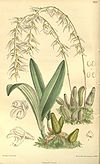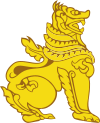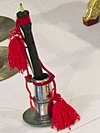
Myanmar, officially the Republic of the Union of Myanmar, formerly known as Burma, is a country in Southeast Asia. It is the largest country in Mainland Southeast Asia, and has a population of about 54 million as of 2017. Myanmar is bordered by Bangladesh and India to its northwest, China to its northeast, Laos and Thailand to its east and southeast, and the Andaman Sea and the Bay of Bengal to its south and southwest. The country's capital city is Naypyidaw, and its largest city is Yangon (Rangoon).

Arunachal Pradesh is a state in Northeastern India. It was formed from the erstwhile North-East Frontier Agency (NEFA) region, and became a state on 20 February 1987. It borders the states of Assam and Nagaland to the south. It shares international borders with Bhutan in the west, Myanmar in the east, and a disputed border with China in the north at the McMahon Line. Itanagar is the state capital of Arunachal Pradesh. Arunachal Pradesh is the largest of the Seven Sister States of Northeast India by area. Arunachal Pradesh shares a 1,129 km border with China's Tibet Autonomous Region.

The hammer and sickle is a symbol meant to represent proletarian solidarity – a union between agricultural and industrial workers. It was first adopted during the Russian Revolution, the hammer representing workers and the sickle representing the peasants.
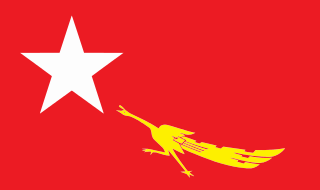
The National League for Democracy is a liberal democratic political party in Myanmar (Burma). It became the country's ruling party after a landslide victory in the 2015 general election but was overthrown in a military coup d'état in early 2021 following another landslide election victory in 2020.

Mizoram is a state in Northeast India, with Aizawl as its seat of government and capital city. The name of the state is derived from "Mizo", the self-described name of the native inhabitants, and "Ram", which in the Mizo language means "land." Thus "Mizo-ram" means "land of the Mizos". Within India's northeast region, it is the southernmost landlocked state, sharing borders with three of the Seven Sister States, namely Tripura, Assam and Manipur. The state also shares a 722-kilometre (449 mi) border with the neighbouring countries of Bangladesh and Myanmar.
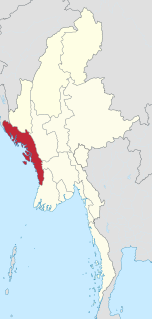
Rakhine State is a state in Myanmar (Burma). Situated on the western coast, it is bordered by Chin State to the north, Magway Region, Bago Region and Ayeyarwady Region to the east, the Bay of Bengal to the west and the Chittagong Division of Bangladesh to the northwest. It is located approximately between latitudes 17°30' north and 21°30' north and longitudes 92°10' east and 94°50' east. The Arakan Mountains or Rakhine Yoma separated Rakhine State from central Burma from North to South. Off the coast of Rakhine State there are some fairly large islands such as Ramree, Cheduba and Myingun. Rakhine State has an area of 36,762 square kilometres (14,194 sq mi) and its capital is Sittwe.

The Karen, also known as the Kayin, Kariang or Kawthoolese, are an ethnolinguistic group of Sino-Tibetan language–speaking peoples. The group as a whole is heterogeneous and disparate as many Karen ethnic groups do not associate or identify with each other culturally or linguistically. These Karen groups reside primarily in Kayin State, southern and southeastern Myanmar. The Karen, approximately five million people, account for approximately seven percent of the Burmese population. Many Karen have migrated to Thailand, having settled mostly on the Myanmar–Thailand border. A few Karen have settled in the Andaman and Nicobar Islands, India, and other Southeast Asian and East Asian countries.

Pailin is a province in western Cambodia at the northern edge of the Cardamom Mountains near the border of Thailand. This province is surrounded by Battambang province, and was officially carved out of Battambang to become a separate administrative division after the surrender of the Ieng Sary faction of the Khmer Rouge in 1996. Pailin is known to much of the world for having long been a stronghold of the Khmer Rouge, remaining under their control long after they were defeated in 1979 and serving from 1994 to 1998 as the capital of the Provisional Government of National Union and National Salvation of Cambodia. Within Cambodia, Pailin is known for its natural resources, namely precious gems and timber.

Tea culture is defined by the way tea is made and consumed, by the way the people interact with tea, and by the aesthetics surrounding tea drinking.

The Bamar are a Southeast Asian Sino-Tibetan ethnic group native to Myanmar. The Bamar live primarily in the Irrawaddy River basin and speak the Burmese language, which is the sole official language of Myanmar at a national level. Bamar customs and identity are closely intertwined with the broader culture of Myanmar.

The State Seal of the Republic of the Union of Myanmar is used in all official government documents, including publications. As the seal is an official symbol, there are State Seal Law and Principles regarding appropriate usage of it.
The Tai Le script, or Dehong Dai script, is a Brahmic script used to write the Tai Nüa language spoken by the Tai Nua people of south-central Yunnan, China. It is written in horizontal lines from left to right, with spaces only between clauses and sentences.

The president of the Republic of the Union of Myanmar is the head of state and constitutional head of government of Myanmar. The president leads the Cabinet of Myanmar, the executive branch of the Burmese government. The current president is Myint Swe, who assumed the presidency in an acting capacity through a military coup d'état on 1 February 2021.

The national symbols of the Philippines consist of symbols that represent Philippine traditions and ideals and convey the principles of sovereignty and national solidarity of the Filipino people. Some of these symbols namely the national flag, the Great Seal, the coat of arms and the national motto are stated in the Flag and Heraldic Code of the Philippines, which is also known as Republic Act 8491. In the Constitution of the Philippines, the Filipino language is stated as the national language of the Philippines. Aside from those stated symbols in the Constitution and in Republic Act 8491, there are only six official national symbols of the Philippines enacted through law, namely sampaguita as national flower, narra as national tree, the Philippine eagle as national bird, Philippine pearl as national gem, arnis as national martial art and sport and the Filipino Sign Language as the national sign language. Thus, there is a total of twelve official national symbols passed through Philippine laws.

The Shan Nationalities League for Democracy is a political party in Myanmar (Burma). The party was established on 26 October 1988, and campaigns for the interests of the Shan people. The SNLD became the largest Shan party in the Assembly of the Union following the 2015 general election. The party is a federal party having local branches in most townships in Shan State and few in other states and regions such as Kayah, Kachin, and Mandalay.

The Pyidaungsu Hluttaw is the de jure national-level bicameral legislature of Myanmar established by the 2008 National Constitution. The Pyidaungsu Hluttaw is made up of two houses, the Amyotha Hluttaw, a 224-seat upper house as well as the Pyithu Hluttaw, a 440-seat lower house.

The Zomi Congress for Democracy is a political party in Myanmar. Most of the party's support comes from Chin State, where the original ZNC was headquartered. The party is most popular in the Tonzang and Tedim Townships, where their headquarters and strongholds are. The party has 15,000 members in Chin State.

The Arakan Liberation Party is a Rakhine political party in Myanmar (Burma). The party has an armed wing, the Arakan Liberation Army (ALA), which has 700–1,000 personnel. The ALA signed a ceasefire agreement with the government of Myanmar on 5 April 2012 and became a signatory of the Nationwide Ceasefire Agreement (NCA) on 15 October 2015.

The National Unity Government of the Republic of the Union of Myanmar is a Myanmar government in exile formed by the Committee Representing Pyidaungsu Hluttaw (CRPH), a group of elected lawmakers and members of parliament ousted in the 2021 Myanmar coup d'état. The European Parliament has recognized the NUG as the legitimate government of Myanmar. It includes representatives of the National League for Democracy, ethnic minority insurgent groups, and various minor parties. The State Administration Council—the country's ruling military junta—has declared the NUG illegal and a terrorist organization.

General elections are expected to be held in Myanmar, possibly sometime in 2023. Voters will elect representatives to both the Amyotha Hluttaw and the Pyithu Hluttaw of the Assembly of the Union. The elections will be the first after the 2021 coup d'état.


